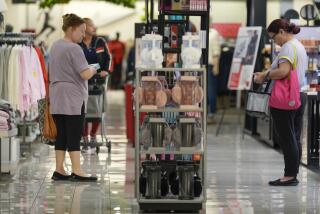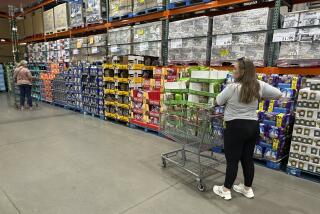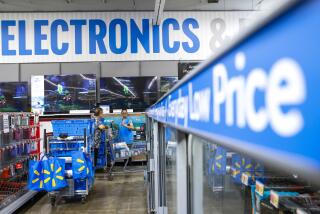July Factory Orders Post Unexpected Rise
- Share via
WASHINGTON — U.S. factories hummed this summer and shoppers returned to the nation’s retail stores, according to new economic data released Thursday, suggesting economic growth continued at a robust pace.
Factory orders inched up only 0.2% in July, but that was enough to raise orders to a record seasonally adjusted $330.3 billion, the Commerce Department said.
Economists had been looking for a small decline. The unexpected increase came atop a strong 1.7% gain in June, the largest in five months and better than the 1.2% estimated a month ago.
Meanwhile, major retailers, who suffered through a dismal spring and early summer, reported that buyers snapped up new fall merchandise in August, especially children’s clothes and personal computers.
“This is further evidence to support the idea the consumer is back and that the spring lull was just that, a lull and not a trend,” said economist Dan Laufenberg of American Express Financial Advisors Inc. in Minneapolis.
August’s sales gains were led by back-to-school sales at discounters such as Kmart, Wal-Mart and Target. Children’s clothes and school supplies helped boost Kmart’s same-store sales 6.4%. Wal-Mart’s sales rose 7.1% and Target’s rose 8%. Department store and specialty chains also reported good sales gains, although not as big as those of the discount retailers.
Analysts were split over whether the new data could mean that the Federal Reserve Board will be more likely to raise interest rates to slow the economy and preempt any acceleration of inflation.
Monetary policymakers haven’t touched short-term interest rates since March, but Laufenberg said chances are better than even that they will nudge rates up by a quarter percentage point when they meet Sept. 30.
However, economist James Glassman of Chase Securities Inc. said there are few bottlenecks that might create price-increasing shortages and delivery delays.
In an indication factories are keeping up with the flow of new orders, shipments--a measure of current production--rose 1.4% in July. That whittled the backlog of unfilled orders by 0.5%, the first drop since April. Inventories increased 0.5%, the 12th rise in 13 months and a sign that manufacturers won’t need to play catch-up to meet future demand.
Moreover, some of the strongest growth in factory orders was registered for equipment that should improve manufacturers’ capacity to keep up with consumer demand. Orders for industrial machinery rose 6.6%, with engines and turbines registering a 29.1% jump.
“I don’t think there are any major imbalances,” Glassman said. “That leaves the Fed on the sidelines for a while.”
In a speech in Boston, Federal Reserve Board member Laurence H. Meyer gave no hint of the central bank’s future course.
“The economy has been functioning very well. Inflation is at a 30-year low, the unemployment rate is at a 24-year low,” he said.
Economists and investors are awaiting a Labor Department report today on the unemployment rate, job growth and wage gains in August. Analysts expect the jobless rate to hold at 4.8% even though the United Parcel Service of America strike and other work stoppages depressed net job growth.
Labor market conditions are considered crucial to whether inflation accelerates, because wages and benefits account for about two-thirds of product prices.
On Thursday, the Labor Department said first-time claims for unemployment benefits edged 2,000 higher last week to a seasonally adjusted 326,000.
(BEGIN TEXT OF INFOBOX / INFOGRAPHIC)
Factory Orders
New Orders, in billions of dollars, seasonally adjusted:
July 1997: $330.3
* Source: Commerce Department
More to Read
Inside the business of entertainment
The Wide Shot brings you news, analysis and insights on everything from streaming wars to production — and what it all means for the future.
You may occasionally receive promotional content from the Los Angeles Times.










